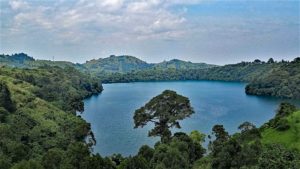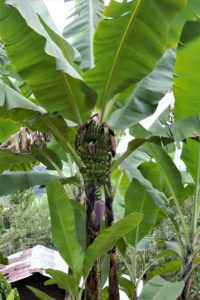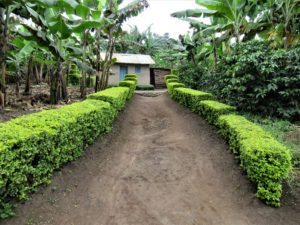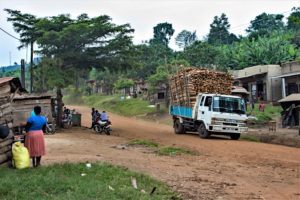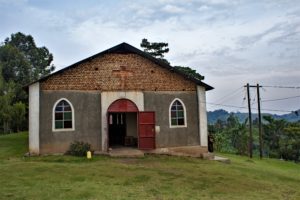The crater lakes area of Uganda is located in the west of the country and whilst we were staying at Papaya Lake Lodge, we took a walk with Noah a guide with Uganda Crater Lakes Tours.
Setting off mid-afternoon when it was cooler, Noah told us that the crater lakes were formed 8,000-10,000 years ago by violent volcanic activity, with exploding ash and rock travelling far and wide. In total contrast the lakes now offer serene and scenic views. Noah explained that as we would be walking through communities, we were likely to attract the attention of children fascinated by the muzungu or white person.
Our trek took us around three lakes, with Noah stopping frequently to talk about the various plants we were passing, including the exotic, highly invasive Lantana Camera and the milky, toxic sap of the euphorbia.
As we walked through banana plantations Noah explained how the banana differs from the plantain, how they reproduce with one plant giving ten more, and interestingly how when the flower comes out, the fruits originally grow downwards but then change direction. He talked about the various uses for banana leaves and said the Chinese are starting to use them for wigs.
The rich dark volcanic soil is ideal for growing a range of crops and we saw papaya, avocado and mango trees, potatoes, sweetcorn, g nuts (ground nuts) and cow peas. Coffee was being grown and beans were drying on tarpaulins on the ground.
Low, lime green privet hedges around homes, looked a little out of place whilst another plant is grown as a boundary marker to denote ownership of land.
Having set off with views of the lake nearest our hotel, Lyantonde, we passed the largest of the three, Nyinambuga, which we had already passed on the drive to our lodge, and which is featured on the 20,000-shilling note. Noah explained that big fish are found in the shallower lakes (some are only 10m deep) and smaller fish are in the deeper lakes. Our final lake, Kifaruka, was covered with water lilies and there was a story how the local people thought that when it was covered with the leaves, they thought the lake had disappeared and then returned when the lilies died.
Near our viewpoint was a church and I asked to look around. The seating arrangements were explained: single girls sit on plain benches at the back until they marry, when they are automatically enrolled in the Mothers Union and are entitled to sit on pews at the front.
Our two-hour walk had been fascinating and fortunately despite being at altitude, the walking had been relatively easy, apart from the final very steep incline back to the lodge where reviving chilled Nile Special beers were the order of the day.
